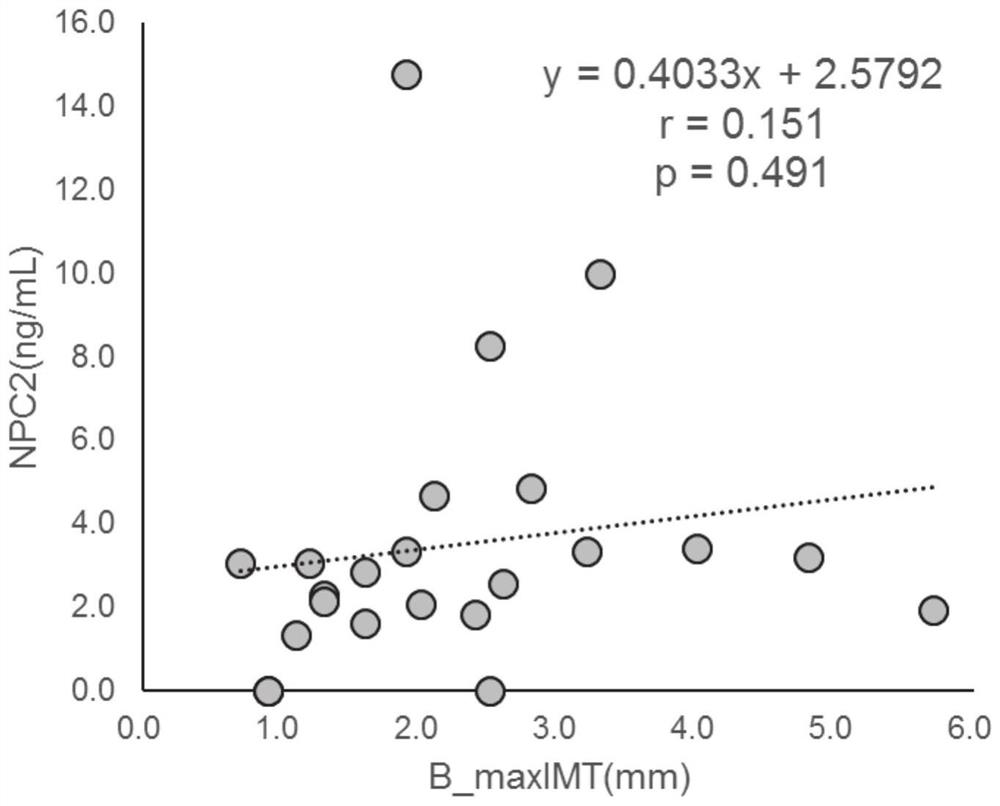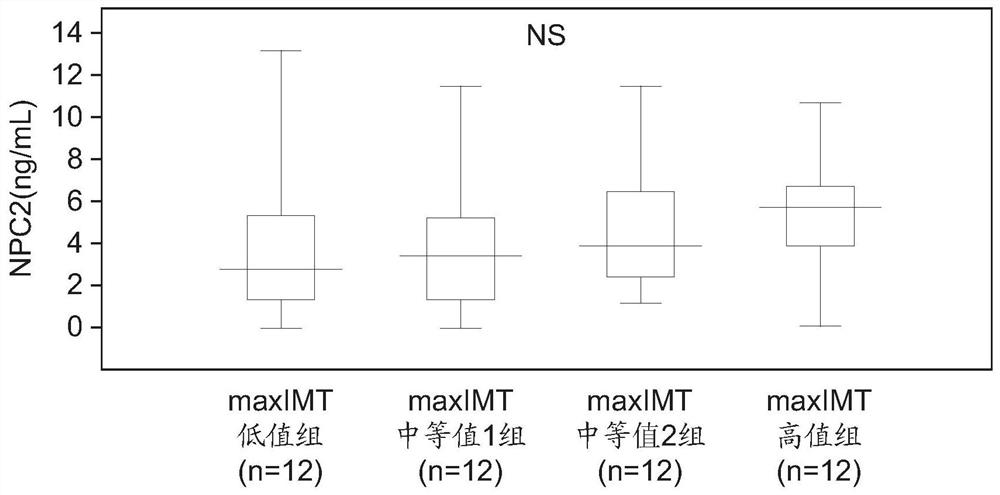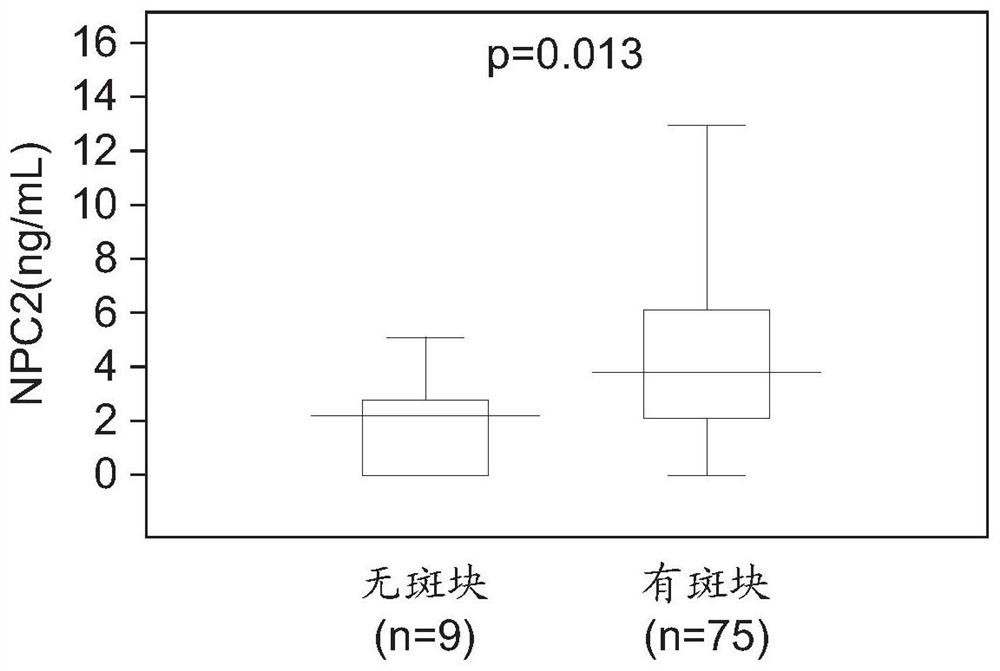Arteriosclerosis and arteriosclerosis-related disease marker
An arteriosclerosis and marker technology, applied in disease diagnosis, cardiovascular system diseases, anti-animal/human immunoglobulin, etc., can solve problems such as unsuitability and unacceptable inspection throughput, and achieve the effect of avoiding deterioration.
- Summary
- Abstract
- Description
- Claims
- Application Information
AI Technical Summary
Problems solved by technology
Method used
Image
Examples
Embodiment 1
[0110] The relationship between serum NPC2 value and maxIMT value, plaque
[0111] Patients with aortic aneurysm, aortic dissection, arteriosclerotic occlusive disease of the lower extremities, and myocardial infarction were used as subjects, and the serum concentration of NPC2 was measured by ELISA, the maxIMT value of the carotid bulb by ultrasound examination, and the carotid artery Comparison of ultrasonographic plaque findings (with and without plaque). NPC2 was determined by using NPC2 ELISA kit (AvivaSystems Biology Company) and following the protocol attached to the kit. The maxIMT value is the maximum wall thickness including carotid bulb plaque measured using the Aplio series manufactured by Canon Medical Systems Co., Ltd. In the ultrasonography, the group in which the presence of plaque was confirmed was defined as the plaque presence (plaque) group, and the group in which no obvious plaque was confirmed was defined as the plaque-free group, thereby determining the...
Embodiment 2
[0117] The relationship between serum NPC2 value and baPWV value
[0118] Patients with aortic aneurysm, aortic dissection, lower extremity arteriosclerotic obliterans and myocardial infarction were used as subjects, and the serum concentration of NPC2 was measured by ELISA method, and compared with the baPWV value. The serum concentration of NPC2 was measured according to the method described in Example 1. The baPWV value was measured using BP-203RPEII (Exceed) manufactured by Nippon Colin Corporation.
[0119] The comparative analysis of serum NPC2 value and baPWV value was carried out as follows: For a total of 85 cases (49 cases of aortic aneurysm, 11 cases of aortic dissection, 8 cases of lower extremity arteriosclerotic obliterans, and 17 cases of myocardial infarction), the critical value of baPWV was used as 1400 (cm / s) or 1700 (cm / s) were divided into two groups, and the serum NPC2 value of each group was investigated. Mann-Whitney's U test was used in statistical p...
Embodiment 3
[0122] The relationship between serum IGFBP7 value and maxIMT value, plaque
[0123] The same patient as in Example 1 was used as a test subject, and the serum concentration of IGFBP7 was measured by ELISA, and the maxIMT value of the carotid bulb and the plaque found by carotid ultrasound examination (with or without plaque) were carried out. )Comparison. IGFBP7 was measured using an ELISA kit for insulin-like growth factor binding protein 7 (cloud-clone company), and was measured according to the protocol attached to the kit. The measurement of the maxIMT value and the determination of the presence or absence of plaque were carried out according to the method described in Example 1.
[0124]Specifically, in the measurement of the IGFBP7 concentration by the ELISA method, a diluted serum sample was added to the solid phase plate of the anti-IGFBP7 antibody and incubated. Then, remove the sample solution, add detection reagent A solution and incubate. After the incubation, ...
PUM
| Property | Measurement | Unit |
|---|---|---|
| Sensitivity | aaaaa | aaaaa |
Abstract
Description
Claims
Application Information
 Login to View More
Login to View More - R&D
- Intellectual Property
- Life Sciences
- Materials
- Tech Scout
- Unparalleled Data Quality
- Higher Quality Content
- 60% Fewer Hallucinations
Browse by: Latest US Patents, China's latest patents, Technical Efficacy Thesaurus, Application Domain, Technology Topic, Popular Technical Reports.
© 2025 PatSnap. All rights reserved.Legal|Privacy policy|Modern Slavery Act Transparency Statement|Sitemap|About US| Contact US: help@patsnap.com



